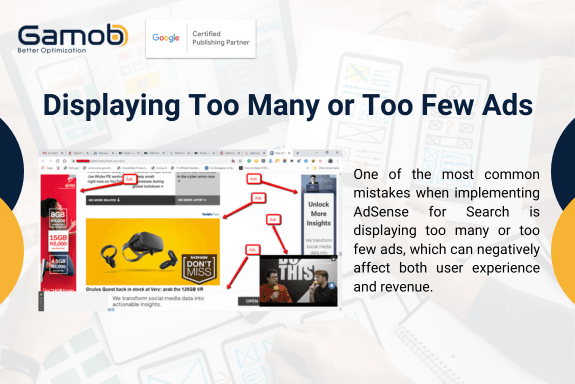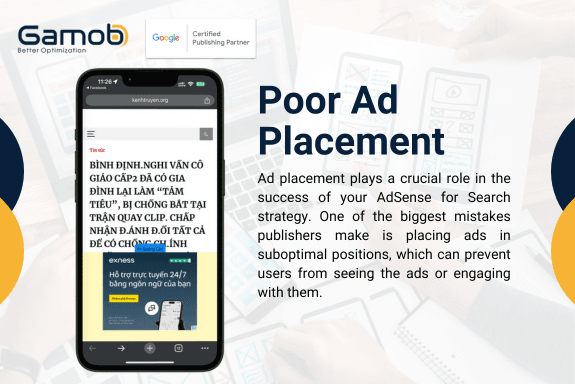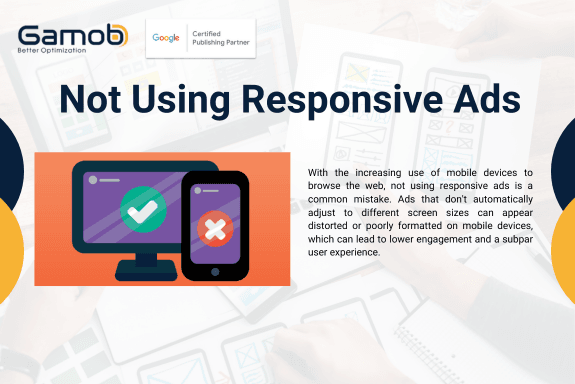Publisher Resources
5 Common mistakes you should avoid when using Adsense for Search
Tracy Nguyen
November 28, 2024

Subscribe to receive the latest blog posts to your inbox every week.
By subscribing you agree to with our Privacy Policy.
Google AdSense for Search (AFS) is a powerful tool for publishers looking to monetize their websites by serving relevant ads based on user search queries. However, like any other advertising tool, success with AFS is not just about placing ads on your site — it’s about how you place them, how you design them, and ensuring they align with user behavior and preferences. Over the years, Gamob have noticed that even small adjustments in ad placement and design can have a significant impact on both user experience and ad performance.
Below, we’ll go through 5 common mistakes publishers often make when using AdSense for Search and share how you can fix them to optimize your ad strategy, enhance user experience, and maximize your revenue.
5 common mistakes publishers often make when using AdSense for Search and solutions for overcoming
1. Displaying Too Many or Too Few Ads
One of the most common mistakes when implementing AdSense for Search is displaying too many or too few ads, which can negatively affect both user experience and revenue.
Too Many Ads: Overloading your website with too many ads can overwhelm visitors and make your site feel cluttered. This can lead to higher bounce rates and hurt your SEO rankings, as users are more likely to leave your site quickly.
Too Few Ads: On the other hand, showing too few ads means you're missing out on monetization opportunities. If you don’t show enough ads, you might not fully capitalize on the traffic your search functionality is driving to your site.

How to fix it:
Optimize ad quantity: Aim for a reasonable number of ads on each page. Too many ads can be disruptive, while too few can result in missed revenue. Place ads where they naturally fit in the search results to make them relevant without overloading the page.
Monitor ad performance: Use Google AdSense analytics to track the performance of each ad unit. If an ad unit isn't performing well, experiment with different placements or formats to improve results.
2. Irrelevant Ads
Another common mistake is serving irrelevant ads that don’t align with what users are searching for. If the ads are not relevant to the user’s search query, the Click-Through Rate (CTR) will drop, and your revenue will suffer.
How to fix it:
Check search keywords: Make sure that the search terms users are entering on your site are closely aligned with the ads being served. This can be achieved by optimizing your content for relevant keywords and ensuring that your AdSense for Search is pulling in the right ads based on those queries.
Optimize content for search: Regularly update and improve the content on your website to ensure it matches the most common and relevant search queries. This not only enhances ad relevance but also boosts SEO and increases organic traffic.
3. Poor Ad Placement
Ad placement plays a crucial role in the success of your AdSense for Search strategy. One of the biggest mistakes publishers make is placing ads in suboptimal positions, which can prevent users from seeing the ads or engaging with them.

How to fix it:
Place ads naturally within the content: AdSense for Search ads should be placed in positions where they feel like part of the user’s search experience. For example, showing ads directly within the search results page ensures they are highly relevant and less disruptive.
“Above the fold” placements: Ensure ads are visible without users having to scroll. Placing ads above the fold, particularly on the search results page, increases the likelihood that users will see and engage with them.
4. Not Using Responsive Ads
With the increasing use of mobile devices to browse the web, not using responsive ads is a common mistake. Ads that don't automatically adjust to different screen sizes can appear distorted or poorly formatted on mobile devices, which can lead to lower engagement and a subpar user experience.

How to fix it:
Implement responsive ads: Use responsive ad units that automatically adjust their size and format based on the user’s device. Responsive ads ensure that your ads look good and perform well on any screen size, from desktops to mobile phones.
Test across devices: After setting up responsive ads, make sure to test your site across multiple devices to ensure the ads look great and function well. A seamless mobile experience is essential for maintaining high engagement rates.
5. Failing to Monitor Ad Performance Regularly
One of the key reasons why ad campaigns underperform is failing to regularly monitor ad performance. Google AdSense for Search offers detailed performance reports, but without actively using them, you may miss valuable insights that could help you optimize your strategy.
How to fix it:
Use AdSense reporting tools: Regularly review your AdSense reports to track metrics like CTR, CPC, and eCPM. These insights will help you understand which ads are performing well and which are underperforming.
Make data-driven adjustments: Based on the performance data, adjust your ad strategy as needed. This could include changing ad placements, experimenting with new ad formats, or testing different keywords to improve ad relevance.
AdSense for Search (AFS) is a powerful monetization tool, but to unlock its full potential, you need to avoid common mistakes like displaying too many or too few ads, irrelevant ad content, poor ad placements, and not optimizing for mobile. By following best practices for ad placement, ad design, and performance monitoring, you can increase both user engagement and revenue from AdSense for Search.
As a Google Certified Publishing Partner, Gamob is here to help you navigate the complexities of AdSense and optimize your strategy for maximum revenue. If you're looking to get the most out of your AdSense for Search setup, don't hesitate to reach out to us for expert guidance.
---------------------
Gamob | GCPP - Empower your monetization journey
Email: [email protected]
Website: www.gamob.com
Linkedin: www.linkedin.com/company/gamob-gcpp
LATEST
Stay informed with our latest blog posts.

Discover the top 15 ad networks for publishers in 2024 and boost your earnings. Learn which networks offer the highest payouts and best features.
Tracy Nguyen
July 15, 2024

Unlock 2024's app monetization secrets! Get the latest strategies for publishers, plus how Gamob is revolutionizing mobile ad revenue growth.
Tracy Nguyen
July 15, 2024

Want to excel in game development? The Digital Game Maturity Model (DGMM) is your go-to guide. Learn the new standards today.
Tracy Nguyen
July 15, 2024